View in other NatureServe Network Field Guides
NatureServe
Montana
Utah
Wyoming
Idaho
Wisconsin
British Columbia
South Carolina
Yukon
California
New York
Northern Bog Clubmoss - Lycopodium inundatum
Other Names:
Lycopodiella inundata
State Rank Reason (see State Rank above)
Rare in Montana where it is known from only a few occurrences in the western portion of the state. Trend data are unavailable. One population may be negatively impacted or extirpated in the future by proposed activities and all populations are susceptible to changes in hydrology.
- Details on Status Ranking and Review
Population Size
Score2-3 - Very Small to Small: Population size is imprecisely known but is believed to be <10,000 individuals.
CommentNumber of plants difficult to estimate, though abundance/number of stems is low. Extent of populations at 2 known sites not fully documented.
Range Extent
Score1 - Peripheral, Disjunct or Sporadic Distribution in MT: Widespread species that is peripheral, disjunct or sporadically distributed within MT such that it occurs in <5% of the state (<7,500 sq. miles or the combined area of Beaverhead and Ravalli Counties) or is restricted to 4-5 sub-basins.
Area of Occupancy
Score3 - Very Low: Generally occurring in 3 or fewer Subwatersheds (6th Code HUC’s).
Environmental Specificity
Score2 - High: Species is restricted to a highly specialized and limited habitat and is typically dependent upon unaltered, high-quality habitat (C Values of 8-10).
Trends
Score0-2 - Stable to Moderate Declines:
CommentTrend data are unavailable. Habitat generally appears to be stable and it does not appear likely that severe declines have occurred, though it is possible that minor or moderate declines have occurred or may be occuring across the species' range in Montana due primarily to drought conditions.
Threats
Score1 - Medium: 11-30% of the populations are being negatively impacted or are likely to be impacted by one or more activities or agents, which are expected to result in decreased populations and/or habitat quality and/or quantity.
CommentOne population may be negatively impacted by development.
Intrinsic Vulnerability
Score1-2 - Moderate to High Vulnerability.
Raw Conservation Status Score
Score
10 to 14 total points scored out of a possible 19.
General Description
Northern Bog Clubmoss resembles a large moss. It has prostrate or arching stems that root at irregular intervals and give rise to erect branches that are up to 10 cm high. The narrow, pointed leaves are 4-8 mm long and clothe the stems and branches in 8-10 ranks. Each spore is subtended by a bract, or sporophyll, that is similar to the leaves and borne in dense spikes at the top of erect branches. It is difficult to distinguish the fertile and sterile portions of the branches.
Phenology
Producing spores June-July.
Diagnostic Characteristics
Lycopodium annotinum is similar, but the sporophylls are half the length of the vegetative leaves. Lycopodium clavatum has well-differentiated cones of sporophylls, and L. selago has bands of sporophylls that alternate with vegetative leaves. Lycopodium inundatum is the only species occurring in standing water of peatlands.
Species Range
Montana Range
Range Descriptions
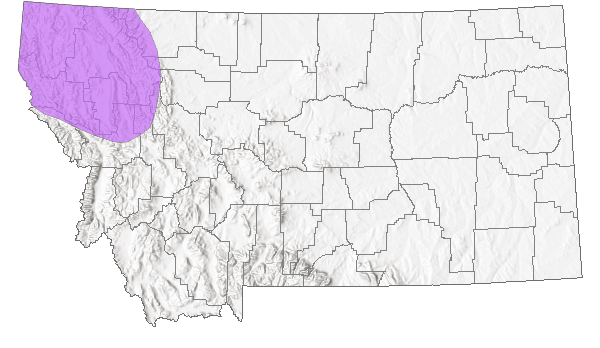
 Native
Native
Range Comments
In MT known from Flathead and Missoula counties; BC to CA, MT and NL to OH and WV (Lesica et al. 2012. Manual of Montana Vascular Plants. BRIT Press. Fort Worth, TX).
Observations in Montana Natural Heritage Program Database
Number of Observations: 12
(Click on the following maps and charts to see full sized version)
Map Help and Descriptions
Relative Density
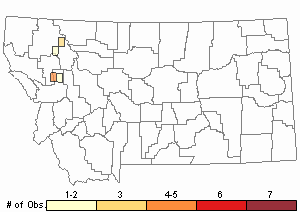
Recency

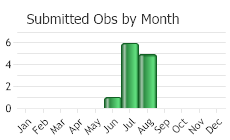
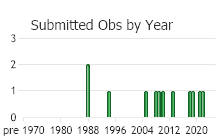
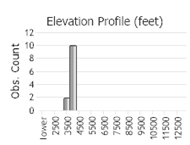 (Observations spanning multiple months or years are excluded from time charts)
(Observations spanning multiple months or years are excluded from time charts)
Habitat
Wet, organic soil of nutrient-poor fens in the valley and lower montane zones.
National Vegetation Classification System Groups Associated with this Species
Wetland and Riparian
Peatland
Stewardship Responsibility
References
- Literature Cited AboveLegend:
 View Online Publication
View Online Publication Lesica, P., M.T. Lavin, and P.F. Stickney. 2012. Manual of Montana Vascular Plants. Fort Worth, TX: BRIT Press. viii + 771 p.
Lesica, P., M.T. Lavin, and P.F. Stickney. 2012. Manual of Montana Vascular Plants. Fort Worth, TX: BRIT Press. viii + 771 p.
- Additional ReferencesLegend:
 View Online Publication
View Online Publication
Do you know of a citation we're missing? Bowles, M. L., M. M. DeMauro, N. Pavlovic, and R. D. Hiebert. 1990. Effects of anthropogenic disturbances on endangered and threatened plants at the Indiana Dunes National Lakeshore. Natural Areas Journal. 10(4): 187-200.
Bowles, M. L., M. M. DeMauro, N. Pavlovic, and R. D. Hiebert. 1990. Effects of anthropogenic disturbances on endangered and threatened plants at the Indiana Dunes National Lakeshore. Natural Areas Journal. 10(4): 187-200. Bursik, R. J., and R. K. Moseley. 1992. Forty-year changes in Hager Lake Fen, Bonner County, Idaho. Cooperative Challenge Cost-share Project, Idaho Panhandle National Forests and Idaho Conservation Data Center, Idaho Department of Fish and Game, Boise. 31 pp.
Bursik, R. J., and R. K. Moseley. 1992. Forty-year changes in Hager Lake Fen, Bonner County, Idaho. Cooperative Challenge Cost-share Project, Idaho Panhandle National Forests and Idaho Conservation Data Center, Idaho Department of Fish and Game, Boise. 31 pp. Caicco, S. L. 1987. Field investigations of selected sensitive plant species on the Idaho Panhandle National Forest. Idaho Natural Heritage Program, Idaho Department of Fish and Game, Boise, Idaho. 44 pp.
Caicco, S. L. 1987. Field investigations of selected sensitive plant species on the Idaho Panhandle National Forest. Idaho Natural Heritage Program, Idaho Department of Fish and Game, Boise, Idaho. 44 pp. Gillespie, J.P. 1962. A theory of relationships in the Lycopodium inundatum complex. American Fern Journal. 52: 19-26.
Gillespie, J.P. 1962. A theory of relationships in the Lycopodium inundatum complex. American Fern Journal. 52: 19-26. Lellinger, D.B. 1985. A Field Manual of the Ferns and Fern-Allies of the United States and Canada. Smithsonian Inst. Press. Washington, D.C. B85LEL01PAUS
Lellinger, D.B. 1985. A Field Manual of the Ferns and Fern-Allies of the United States and Canada. Smithsonian Inst. Press. Washington, D.C. B85LEL01PAUS Lesica, P., M.T. Lavin, and P.F. Stickney. 2022. Manual of Montana Vascular Plants, Second Edition. Fort Worth, TX: BRIT Press. viii + 779 p.
Lesica, P., M.T. Lavin, and P.F. Stickney. 2022. Manual of Montana Vascular Plants, Second Edition. Fort Worth, TX: BRIT Press. viii + 779 p. Moseley, R. K., R. J. Bursik, and M. Manusco. 1991. Floristic inventory of wetlands in Fremont and Teton counties, Idaho. Unpublished report on file IDCDC Department of Fish & Game, Boise, ID. 60 pp.
Moseley, R. K., R. J. Bursik, and M. Manusco. 1991. Floristic inventory of wetlands in Fremont and Teton counties, Idaho. Unpublished report on file IDCDC Department of Fish & Game, Boise, ID. 60 pp. Rumely, J. H. 1956. Plant ecology of a bog in northern Idaho. Unpublished dissertation, Washington State University, Pullman. 85 pp.
Rumely, J. H. 1956. Plant ecology of a bog in northern Idaho. Unpublished dissertation, Washington State University, Pullman. 85 pp. Shelly, J. S. and M. Mantas. 1993. Noteworthy collections, Montana. Madrono 40:271-273.
Shelly, J. S. and M. Mantas. 1993. Noteworthy collections, Montana. Madrono 40:271-273.
- Web Search Engines for Articles on "Northern Bog Clubmoss"





